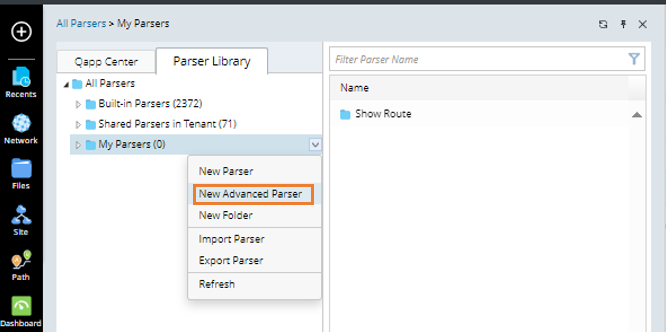10.1.15.12-06212024
Create an SNMP Parser
This section introduces how to create an SNMP Parser to extract key metrics of device data with OIDs.
Example: Parse the free and used memory of a Cisco Router with the corresponding OIDs.
- Go to Parser Library, then click New Advanced Parser from the drop-down menu of a folder. The parser editor will open.

- in the parser editor, keep the default Traditional Devices from the Qualified Devices list and select Cisco Router from the Data Type list.

Tip: The system also supports defining a Parser to retrieve and parse SDN data through APIs. See Creating an API Parser to get details about API Parser.
- Click Advanced to configure the settings for filtering applicable devices as qualified device. For more information, see Qualified Device Filter in Advanced Parser.
- Select SNMP from the Data Type dropdown menu.
- Select an SNMP method (SNMPGet in this sample) from the dropdown menu.
- Enter the following two OIDs in the Command field and separate them with ||.
- Free memory OID: 1.3.6.1.4.1.9.9.48.1.1.1.6.1
- Used memory OID: 1.3.6.1.4.1.9.9.48.1.1.1.5.1


Note: Only the SNMP method SNMPGet supports multiple OID inputs, while SNMPWalk and SDNMPTable support single OID.
- Highlight the free memory value exactly in the sample data and click Define Keyword in the floating menu. The Keyword Parser dialog prompts with the following fields auto-identified. Click Save Variable.

- Sample — the sample command line where the variable stays.
- Parser — defines keywords and where a variable is located. The keyword Parser GAUGE32: $int:var1$ is created automatically. To locate the variable exactly and differentiate it with the used memory value, modify the Parser to 1.3.6.1.4.1.9.9.48.1.1.1.6.1 = GAUGE32: $int:var1$. It contains the keyword 1.3.6.1.4.1.9.9.48.1.1.1.6.1 = GAUGE32: that always stays the same, and the variable $var1 varies in different devices.
- Variable — the variable defined in the Parser. To change the auto-created variable name to a more meaningful name, rename the variable, such as from var1 to free_memory.
- Highlight the used memory value exactly in the sample data, and then follow step 6 to add the variable used_memroy.

Note: In the Parser field of the Keyword Parser dialog, modify the default Parser to 1.3.6.1.4.1.9.9.48.1.1.1.5.1 = GAUGE32: $int:var1$, and rename the variable name as used_memory.
- Click the
 icon on the upper right corner of the page. The Parser will be saved in the Parser Library.
icon on the upper right corner of the page. The Parser will be saved in the Parser Library.
Note: SNMP Parser has two special built-in SNMP parameters: $cpu_oid and $mem_oid, representing a device's CPU and memory usage, respectively. When you use these two parameters in the Command field, select a device to retrieve data, and the system will automatically get the CPU usage and memory usage by looking up the corresponding OID of the device in the domain. 
See also: